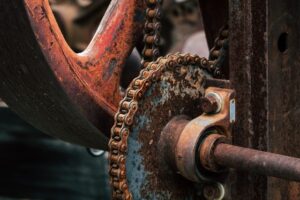Corrosion is a process of gradual material degradation that occurs due to the influence of specific environmental factors on an object. Corrosion may result from chemical reactions as well as physical, electrochemical, or microbiological processes.
Corrosion is most commonly discussed in relation to metals, although in reality it can also affect non-metallic materials such as concrete, wood, or rock.
In the case of metals, the most significant contributors to corrosion are chemical and electrochemical processes. For these materials, it is a natural and inevitable process. It is important to understand that metals inherently strive to return to the form in which they exist in ores. Therefore, it is impossible to fully protect metal from corrosion. Fortunately, appropriate methods and agents can significantly slow down the degradation of steel.
For these materials, it is a natural and inevitable process. It is important to understand that metals inherently strive to return to the form in which they exist in ores. Therefore, it is impossible to fully protect metal from corrosion. Fortunately, appropriate methods and agents can significantly slow down the degradation of steel.
How can you tell that oxidationhas occurred? The most typical symptoms are the rusting of iron and the formation of patina on copper and its alloys. Even stainless steel can corrode if its passive layer is damaged.
The most common causes of corrosion
Many factors contribute to oxidation, one of which is the quality of the manufactured object. If the item is well made and properly protected, the likelihood of corrosion is reduced. However, even very high-quality manufacturing cannot guarantee complete immunity. Certain environmental factors can cause corrosion quickly, regardless of workmanship.
In metals, the main causes of corrosion include:
Water – even young children know that leaving metal in water causes it to rust quickly. Water creates small pits in the metal structure, weakening its surface and accelerating rust formation. It’s essential to protect metal objects not only from water but also from humidity, which can accumulate on the surface and lead to corrosive damage.
Air – although essential for life, it contributes to corrosion, especially when a metal object is exposed to changing temperatures. Fluctuations between above- and below-zero temperatures cause moisture to form, which promotes oxidation.
Salt – both table salt and road salt have corrosive properties, especially when they come into contact with metal. While it’s relatively easy to protect metal from table salt, preventing damage from road salt, particularly in winter, is much more challenging.
How to prevent oxidation?
To prevent corrosion, first ensure metal items are stored properly. They should be kept in a dry place, with low humidity and stable ambient temperature.
If a metal object (e.g. a car body) has been in contact with road salt, clean the wheel arches and sills regularly using a soft, damp cloth.
Many metal items can have corrosion delayed through regular cleaning and maintenance using special protective products.



